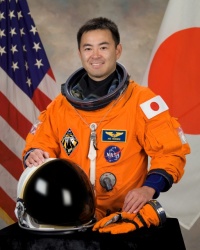Akihiko Hoshide
From The Space Library
 Akihiko Hoshide | |
| Birth Name | Akihiko Hoshide |
|---|---|
| Birth Date | 1968 |
| Occupation | JAXA Astronaut |
Contents |
[edit] Personal Data
Born in 1968 in Tokyo, Japan. He enjoys flying, rugby football, swimming, snow skiing, and travelling.
[edit] Education
Graduated from the United World College of South-East Asia, Singapore, in 1987; received a Bachelor's degree in Mechanical Engineering from Keio University in 1992, and a Master of Science degree in Aerospace Engineering from the University of Houston Cullen College of Engineering in 1997.
[edit] Experience
Hoshide joined the National Space Development Agency of Japan (NASDA) in 1992. For two years, he worked as a member of the Nagoya Office and was involved in the development of the H-II launch vehicle. From 1994 to 1999, he worked as an astronaut support engineer for the NASDA Astronaut Office, supporting the development of the astronaut training program and the evaluation of crew interface designs. He also supported astronaut Koichi Wakata during his training and mission on STS-72.
[edit] Spaceflight Experience
NASA/JAXA EXPERIENCE: In February 1999, Hoshide was selected by NASDA (currently JAXA; Japan Aerospace Exploration Agency) as one of three Japanese astronaut candidates for the International Space Station (ISS). He started the ISS Astronaut Basic Training program in April 1999 and was certified as an astronaut in January 2001. He then participated in ISS Advanced Training, as well as supporting the development of the hardware and operation of the Japanese Experiment Module "Kibo" and the H-IIA Transfer Vehicle (HTV). Hoshide arrived at the Johnson Space Center in May 2004. In February 2006 he completed Astronaut Candidate Training that included scientific and technical briefings, intensive instruction in Shuttle and International Space Station systems, physiological training, T-38 flight training, and water and wilderness survival training. Completion of this initial training qualified him for various technical assignments within the Astronaut Office, and he has worked as a capsule communicator (CAPCOM) in Mission Control Center for the ISS and the Space Shuttle, as well as supported technical coordination for Kibo and HTV. He completed his first space flight on STS-124 in 2008 and has logged over 13 days in space. In May 2004, he completed Soyuz-TMA Flight Engineer-1 training at the Yuri Gagarin Cosmonaut Training Center (GCTC), Star City, Russia. STS-124 Discovery (May 31 to June 14, 2008) was the 123rd Space Shuttle flight, and the 26th Shuttle flight to the International Space Station. STS-124 was launched from the Kennedy Space Center, Florida, and docked with the International Space Station on June 2 to deliver the Japanese Experiment Module-Pressurized Module (JEM-PM) and the Japanese Remote Manipulator System. STS-124 Shuttle astronauts delivered the 37-foot (11-meter) Kibo lab, relocated its rooftop storage room, conducted 3 spacewalks required to maintain the station and to prime the new Japanese module and its robotic arm for work during nine docked days at the orbiting laboratory. STS-124 also delivered a new station crew member, Expedition 17 Flight Engineer Greg Chamitoff. He replaced Expedition 16 Flight Engineer Garrett Reisman, who returned to Earth with the STS-124 crew. Hoshide worked primarily on the outfitting, activation, and reconfiguration of the Kibo module, as well as deploying the Kibo robotic arm from its launch configuration and conducting initial checkout. He also operated the Space Station Remote Manipulator System (SSRMS) to install the Kibo Module to the ISS. The STS-124 mission was completed in 218 orbits, traveling 5,735.643 miles in 13 days, 18 hours, 13 minutes and 7 seconds. Hoshide is assigned and in training as one of the long duration crew member for Expedition 32/33.
[edit] Organizations
The Japan Society for Aeronautical and Space Sciences.
[edit] Special Honours
[edit] Other Information
Sep-10
